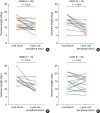2. Smejda K, Polanska K, Merecz-Kot D, Krol A, Hanke W, Jerzynska J, et al. Maternal stress during pregnancy and allergic diseases in children during the first year of life. Respir Care. 2018; 63:70–76.


4. Ghezzi P, Floridi L, Boraschi D, Cuadrado A, Manda G, Levic S, et al. Oxidative stress and inflammation induced by environmental and psychological stressors: a biomarker perspective. Antioxid Redox Signal. 2018; 28:852–872.


5. Ji H, Li XK. Oxidative stress in atopic dermatitis. Oxid Med Cell Longev. 2016; 2016:2721469.

6. Sies H, Berndt C, Jones DP. Oxidative stress. Annu Rev Biochem. 2017; 86:715–748.


7. Allsopp RC, Chang E, Kashefi-Aazam M, Rogaev EI, Piatyszek MA, Shay JW, et al. Telomere shortening is associated with cell division
in vitro and
in vivo. Exp Cell Res. 1995; 220:194–200.

8. Babizhayev MA, Savel'yeva EL, Moskvina SN, Yegorov YE. Telomere length is a biomarker of cumulative oxidative stress, biologic age, and an independent predictor of survival and therapeutic treatment requirement associated with smoking behavior. Am J Ther. 2011; 18:e209–26.

11. Chang HY, Suh DI, Yang SI, Kang MJ, Lee SY, Lee E, et al. Prenatal maternal distress affects atopic dermatitis in offspring mediated by oxidative stress. J Allergy Clin Immunol. 2016; 138:468–475.e5.


12. Bradley KL, Bagnell AL, Brannen CL. Factorial validity of the Center for Epidemiological Studies Depression 10 in adolescents. Issues Ment Health Nurs. 2010; 31:408–412.


13. Hahn DW, Lee CH, Chon KK. Korean adaptation of Spielberger's STAI (K-STAI). Korean J Health Psychol. 1996; 1:1–14.
14. Kim KH. Overview of atopic dermatitis. Asia Pac Allergy. 2013; 3:79–87.

15. Kimura M, Stone RC, Hunt SC, Skurnick J, Lu X, Cao X, et al. Measurement of telomere length by the Southern blot analysis of terminal restriction fragment lengths. Nat Protoc. 2010; 5:1596–1607.


16. Okuda K, Bardeguez A, Gardner JP, Rodriguez P, Ganesh V, Kimura M, et al. Telomere length in the newborn. Pediatr Res. 2002; 52:377–381.


17. Benjamini Y, Yekutieli D. The control of the false discovery rate in multiple testing under dependency. Ann Stat. 2001; 29:1165–1188.

18. Marchetto NM, Glynn RA, Ferry ML, Ostojic M, Wolff SM, Yao R, et al. Prenatal stress and newborn telomere length. Am J Obstet Gynecol. 2016; 215:94.e1–94.e8.

20. Elbers CC, Garcia ME, Kimura M, Cummings SR, Nalls MA, Newman AB, et al. Comparison between southern blots and qPCR analysis of leukocyte telomere length in the health ABC study. J Gerontol A Biol Sci Med Sci. 2014; 69:527–531.


22. Werlang IC, Hahn MC, Bernardi JR, Nast M, Goldani MZ, Michalowski MB. Exposure to different intrauterine environments: implications for telomere attrition in early life. J Matern Fetal Neonatal Med. 2018; 31:1–10.


24. Loo EX, Shek LP, Goh A, Teoh OH, Chan YH, Soh SE, et al. Atopic dermatitis in early life: evidence for at least three phenotypes? results from the GUSTO study. Int Arch Allergy Immunol. 2015; 166:273–279.











 PDF
PDF ePub
ePub Citation
Citation Print
Print



 XML Download
XML Download